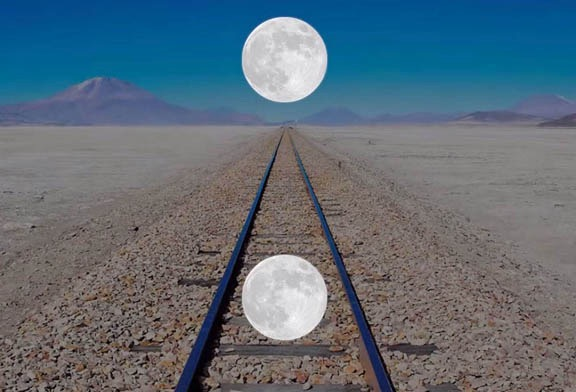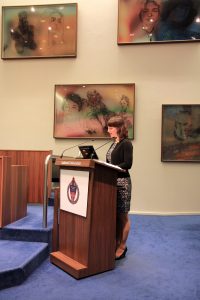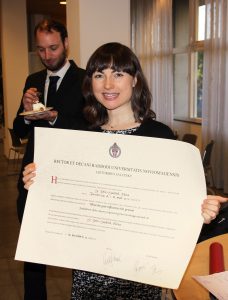This post is also available in Dutch.
When the Past Influences the Present: A PhD Thesis
“We judge the things we see now to be similar to the things we saw in the past, even though they are actually different,” concludes recently graduated neuroscientist Dr. Elexa St. John-Saaltink.
We, humans, rely heavily on our sense of sight. We often assume that we see exactly what is present in the world around us, but actually this is not the case. Many visual illusions have shown that we perceive our surroundings differently from what they truly are.
For instance, take a look at the following image:

Image credits: NASA
If you had to say which moon was larger, you’d probably say that the one in the sky was bigger. It certainly appears this way, but in fact the two moons are exactly the same size. This illusion occurs because of the countless times we observed the world; we have learned that things appear smaller when they get farther away from us. Our brain notices the converging railway, the mountains in the distance, and the texture of the sand diminishing. These details make us think that the moon up in the sky is further away from us than the moon on the ground. This makes us perceive the moon above as larger than the moon below.
What you saw before affects what you see now
In her research, Dr. Elexa St. John-Saaltink studied how past information can affect what we see. In one of her experiments, people looked at objects one after the other containing faint oriented lines. People had to answer whether these lines were oriented more leftwards or rightwards. Interestingly, if the previous lines were oriented leftwards, people would say that the current lines were oriented leftwards when in fact these lines were oriented rightwards. This shows how images we saw previously influence the way we see images currently.
Your current brain activity is also affected by what you saw before
While people carried out the experiment, their brain activity was recorded with fMRI. The activity of visual brain areas when observing a current object resembled the activity of the object seen previously. This means that our brain judges what we see now as being more similar to what we saw in the past than it actually is!
The PhD defense
Having discovered these intriguing effects of past information on the visual system, Dr. Elexa St. John-Saaltink successfully defended her thesis on the 5th of December, 2016. Yes, that’s correct: on the day the Dutch celebrate Sinterklaas! Each PhD defense concludes with a speech about the new graduate to be given by the supervisor. Therefore, in accordance with Sinterklaas tradition, Elexa’s supervisor, Dr. Floris de Lange, delivered the speech in the form of a Sinterklaas poem. What a fantastic way to celebrate one’s PhD degree!



Image credits: Elexa St. John-Saaltink
For more information, read this article about Elexa’s work on the website of the NWO agency (in Dutch).
